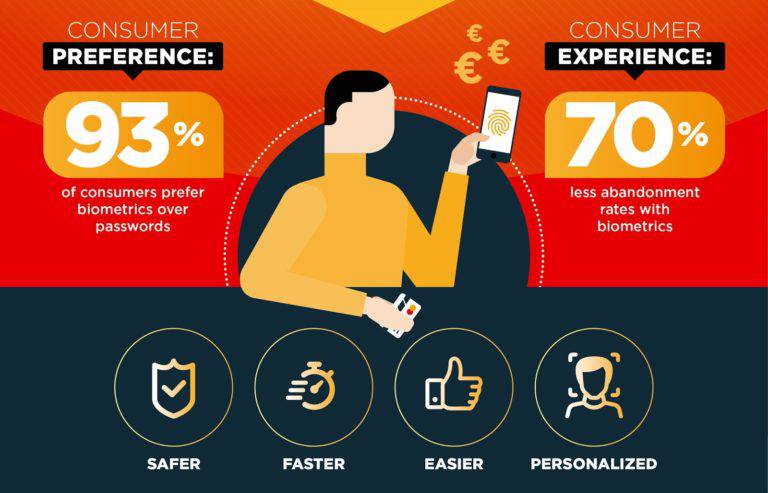
Beyond its attempt to make everything from payments to vehicles more secure, biometrics is also enabling a wide range of industries to become more scalable and efficient. The biometric industry is projected to be worth as much as $59B by 2025, per CB Insights.
AUTOMOTIVE
- Hyundai offers integrated fingerprint scanning for unlocking and turning on the car in two of its Chinese car models.
- Porsche has partnered with FogHorn to develop a multi-factor authentication prototype that uses real-time facial recognition plus additional authentication via smartphone, which allows drivers to enter into their cars without key fobs.
- Affectiva has developed driver monitoring software that uses physical markets to determine if drivers are alert and paying attention to the road.
BANKING
- Citi has been offering voice authentication to verify customers’ identities since 2016.
- Many financial services providers including Chase, HSBC, and USAA use Apple’s FaceID facial recognition tool to let customers securely log in to their mobile banking apps.
- Barclay’s uses finger vein reader tech for corporate banking clients instead of passwords or PINs for advanced security.
- The Royal Bank of Scotland is also piloting cards that use fingerprints to authenticate transactions worth more than £30.
HEALTHCARE
- Biometric data could enable faster patient identification in emergency situations. It could also help prevent patient fraud and mistaken prescriptions, which are common issues in the healthcare industry. New York’s Northwell Health of New York uses iris scans to address this.
- Biometrics could also protect patient privacy, making their health information available only to those with permission. Authorized doctors could verify their identity with a quick iris or fingerprint scan.
- Using facial recognition or fingerprints as part of multi-factor authentication could also advance telemedicine through accurate patient identification and secure digital access of patient information for the attending doctor.
FOOD & BEVERAGE
- Coca-Cola uses a biometric fingerprint system to track the activity of independent truck drivers entering certain canning sites.
- On the consumer-facing side, many food and beverage corporates are seeking to create a better customer experience using facial recognition technology. KFC, for instance, allows its Chinese customers to pay for meals using a facial detection payment system provided by Alibaba.
HOSPITALITY
- Marriott International has been testing its facial recognition check-in kiosk in two hotels in China, with the entire process taking less than a minute.
- The restaurant industry is also starting to use biometrics to remember customers’ order preferences. For example, Dallas-based BurgerFi and Malibu Poke use facial recognition to speed up the ordering process by bringing up customers’ favorite options.
RETAIL
- Amazon is leading the way in terms of biometric payment systems for retail. It is currently testing a scanner that uses computer vision and depth geometry to identify an individual’s hand as a way to ring up a store purchase.
- The retail giant aims to launch this contactless hand-scanning payment system at certain Whole Foods stores across the US by early 2020, and if successful, Amazon will roll it out to all Whole Foods stores nationwide.
- The Home Depot has reportedly already used its store security footage to track shopper engagement.
- Facial recognition in stores could also combat shoplifting and fraud. Companies like Target, Walmart, and Lowe’s have reportedly been experimenting with the tech to that end.
BORDER CONTROL
- Fingerprints have a high false acceptance and rejection rate. Various countries, including Thailand, UK, Canada, and the US, have been exploring iris scans and facial recognition as more reliable methods of identifying travelers.
LAW ENFORCEMENT
- Biometrics has long been used by law enforcement. DNA and fingerprints are the two most reliably-used types of evidence in a criminal case. Officers can carry personal devices able to quickly scan a suspect’s fingerprints and immediately compare to the Automated Fingerprint Identification System (AFIS).
- Worldwide, a trend of using facial recognition for live video feed identification has been growing. City-wide facial scanning surveillance systems in London, for example, led to the arrest of 3 violent criminals.
- Identifying criminals isn’t the only purpose that facial scanning is serving. TrustStamp is a biometric identification system against human trafficking between the US-Mexico border, aiming to identify victims through facial recognition. It also allows authorities to securely share and confirm that information so that subpoenas and warrants can be issued more efficiently.
- From neurobiometrics for lie detection to large-scale facial recognition in cities and airports for fast identification of known terrorists and criminals, facial recognition is finding more and more uses in law enforcement.
EDUCATION
- Facial recognition or fingerprints can be applied to anything requiring authentication, from lunch programs to dorm access. School faculty could use a similar system to access student grades and personal information.
- Security within school has recently became a growing problem in the United States. Facial recognition can quickly identify any unauthorized presence within school grounds.
- With artificial intelligence better able to read body language and facial features, academic integrity can better be preserved. This is particularly useful in a college exam or standardized testing situation, where proctors may not necessarily notice signs of cheating in large groups of test-takers.
- Students could also benefit from a biometrics identification system that would allow for online test taking identification.

Comments